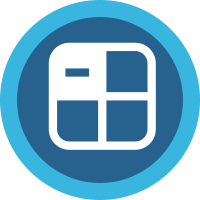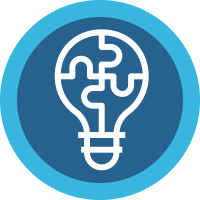Accessible Mathematics Experiences
for Remote Learning
Below, we share seven tips to help you provide remote mathematics learning experiences that are accessible and meaningful for all students, including those with disabilities.
Build on Students’ Strengths
Learning remotely, by necessity, involves more independent learning. While this can be challenging, it also presents great opportunities for students to work on projects that are driven by their interests. Any learner, including students with disabilities, has areas of interest, and organizing mathematics learning and projects around those can be highly motivating. Yet most students beneit from explicit support and structure. Think of mathematics projects that students can do with others—for example, with their peers online or with family members at home. Keep in mind that caregivers may be very busy and have limited bandwidth for helping children with school work. Can you set up projects in which students work together and help each other from diferent locations?

Ask students to work in teams online to conduct a survey on a topic of their choice. A survey project can provide a motivating context for students to learn about statistical concepts such as mean, median, and mode, provide opportunities to practice operations, and learn about different methods for graphing data. By carefully pairing students with different strengths and needs, they can help each other stay on task, explain concepts and procedures to each other, and check each other’s work. Explore additional examples of mathematics projects here.
Keep Goals and Expectations Consistently High for All Students
Remember that all students can and must learn mathematics. Having a disability does not mean a student cannot learn rigorous mathematics. Even in these difficult times, each and every student must know that it is important for them to learn mathematics and have the ability to do so. As you communicate with students about their work, continue to nurture each student’s belief in their abilities as a mathematician. Learn more about how to support students’ growth mindset.
Plan with Students’ Strengths and Needs in Mind
Whether or not students have a diagnosed disability, all students have a learning profile, with strengths and needs in various areas that play a role in learning such as higher-order thinking, memory, language, attention, sequential, spatial, psychosocial, and neuromotor functions. As you design remote learning experiences, it is important to offer multiple options and opportunities that allow students to pursue specific learning goals in different ways. But this doesn’t mean that you need to develop individual learning plans for each and every student.

Think about one to three focal students who are “outliers” in the class—students who stand out as learning differently from others—as you plan to support mathematics learning remotely. What will work best for these students? Chances are that what comes to mind for these students will also work well for many students in your class.
Plan with Mathematical Goals in Mind
It is important to think about goals that go beyond a single learning experience. Plan for the long-term, set goals and design routines that can be sustained, and consider what students are expected to know and be able to do when they enter the next grade. Think about what students have learned so far to identify and prioritize the areas they need to work on to be well prepared for their mathematics work next year.

Instead of focusing on giving students practice with isolated skills, such as dividing fractions, think broadly about what students will need to know and be able to do with fractions next year. Develop a series of learning experiences that build on each other, deepen students’ understanding of part-whole relationships, and give students opportunities to practice a variety of skills and operations involving fractions.
Giving students opportunities to practice mathematics using online games or worksheets can be helpful, but students also need learning experiences that help them build mathematical ideas and use mathematical practices. Learning experiences also need to focus on helping students use mathematical practices that they need to meet the grade-level expectations for the current school year. For guidance on key math concepts and practices that are important for the grade level of the students you work with, consult your state’s standards for mathematics or the Common Core Standards in Mathematics.
Consider the Demands of Remote Learning Experiences in Mathematics
Learning remotely does not mean it needs to be online. Technology can be a big help for diverse learners, but it can also present new access challenges. It is important to think about individual students’ learning profiles to consider what works for them, and to be creative in supporting them. Remote mathematics learning can be supported in many ways, including playing online games, watching videos, listening to podcasts, watching a TV broadcast, making phone calls, using email or text messages, and working on printed materials at home. As you experiment with supporting mathematics learning using new resources and media, think about the neurodevelopmental demands they introduce into learning experiences.

Think about the demands that new resources and media will make on a student’s higher-order thinking, memory, language, attention, sequential, spatial, psychosocial, and neuromotor functions. For example, changing instructions for an activity from spoken language and demonstration to written text may seem minor. But, it alters the language demands and can affect who does and doesn’t have access to the activity.
Collaborate with Your Colleagues
As much as possible, brainstorm ideas, coordinate activities and assignments, and get feedback. If you are a general education teacher, reach out to special education colleagues. If you are a general education teacher, reach out to special education colleagues. If you are a special education teacher, reach out to your general education colleagues. Reach out to teachers from different grade levels to share expectations for the grade you teach, and to learn about expectations at other levels. And specialists—such as a math coach, bilingual educator, or technology coordinator—can provide helpful input, too. If possible, include paraprofessionals or teaching assistants in your conversations.
Collect Data and Reflect on What Is and What Isn’t Working
Whatever goals you choose for your students to work on, you will also need to articulate, for both yourself and for your students, the evidence you will use to determine that the goals have been met. What data or information can you collect to check if the mathematics learning experiences you have planned work for different students? It is easy to think of ways to use distance learning technologies, such as computers and other media, in a broadcast mode. It is more challenging to identify ways to use these tools to provide the opportunity for you to connect with individual students.

Check in with students one-on-one or in small groups to help reduce their feelings of isolation and help you figure out if the learning experiences you are orchestrating are working for them. Connect with families to gain additional lenses on what is and what is not working. Finally, think about the options you have to observe students as they work and use their work products to understand their learning processes. And collaborate with your colleagues to reflect on student work together.
The contents of this blog post were developed under a grant from the Department of Education. However, those contents do not necessarily represent the policy of the Department of Education, and you should not assume endorsement by the Federal Government.
This work is licensed under CC BY-NC-SA 4.0
Math for All is a professional development program that brings general and special education teachers together to enhance their skills in
planning and adapting mathematics lessons to ensure that all students achieve high-quality learning outcomes in mathematics.
